
Attention: Reduced Open Hours
Monday, May 13: 1 pm - 5 pm
We apologize for any inconvenience
An aggregation of UBC Library blogs that highlight the Library’s collections, services, spaces and events.
By elimwong on May 8, 2024

Attention: Reduced Open Hours
Monday, May 13: 1 pm - 5 pm
We apologize for any inconvenience
Posted in Carousel, Featured, General Announcements | Read More | No Comments
By cshriver on May 8, 2024
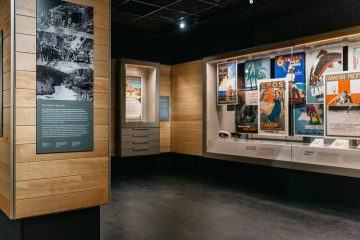 UBC Library is excited to announce the official opening of the Chung | Lind Gallery showcasing the Wallace B. Chung and Madeline H. Chung Collection and Phil Lind Klondike Gold Rush Collection. The new exhibition space in the Irving K. Barber Learning Centre on UBC’s Vancouver campus brings together two library collections of rare and culturally significant materials from Canada’s history.
UBC Library is excited to announce the official opening of the Chung | Lind Gallery showcasing the Wallace B. Chung and Madeline H. Chung Collection and Phil Lind Klondike Gold Rush Collection. The new exhibition space in the Irving K. Barber Learning Centre on UBC’s Vancouver campus brings together two library collections of rare and culturally significant materials from Canada’s history.
Read more about the Chung | Lind Gallery:
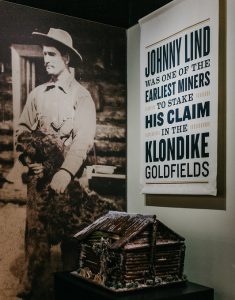 We know that our patrons have missed being able to visit the Chung Collection Room as we have worked to prepare the new gallery. Thank you so much for your patience! We look forward to welcoming you to the new space and also introducing you to the Phil Lind Klondike Gold Rush Collection for the first time.
We know that our patrons have missed being able to visit the Chung Collection Room as we have worked to prepare the new gallery. Thank you so much for your patience! We look forward to welcoming you to the new space and also introducing you to the Phil Lind Klondike Gold Rush Collection for the first time.
The Chung | Lind Gallery, on level 2 of the Irving K. Barber Learning Centre, is open Tuesday-Saturday, 10 am-5 pm. The gallery is free and open to the public, and people of all ages are encouraged to attend. Small group tours and class visits are available by appointment. For more information, please contact (604) 822-3053 or rare.books@ubc.ca.
Posted in Chung, Collections, Exhibitions, Frontpage Exhibition, Lind, Research and learning | Read More | No Comments
By elimwong on May 7, 2024
LAW LIBRARY reference room (level 2): KE4270 .B87 2023
Donald F. Bur, Law of the Constitution: The Distribution of Powers, 2nd ed. (Toronto: LexisNexis, 2023).
LAW LIBRARY level 3: KTX3344 .I23 2020
Paulin Ibanda Kabaka, Mémento du droit minier de la RD Congo: de la législation coloniale au code minier révisé de mars 2018 (Saint-Denis: Édilivre, 2020).
Posted in New Books | Read More | No Comments
By ryan regier on May 3, 2024
Users are seeing a “Sorry, something went wrong trying to log you in.” error when trying to access Canada Commons or Policy Commons.
We are working to resolve the issue.
As a workaround please access via the Resource Pages – https://resources.library.ubc.ca/?searchtype=keywords&search=Commons
Posted in Broken Links, eResources Blog | Read More | No Comments
By epederso on May 2, 2024
PZ7.1.O55 Ev 2023 Everyone’s thinking it / Aleema Omotoni.
Posted in New in the Library, Slideshow | Read More | No Comments
By cshriver on April 30, 2024
Many thanks to guest blogger Barbara Towell, E-Records Manager with University Archives, for contributing the below post. This exhibit was co-curated by Barbara and RBSC Archivist Krisztina Laszlo.

Artray photo. ([1945]). Oscar outside Oscar’s Steak House at 701 Burrard Street (81420). Vancouver Public Library.
Oscar Blanck (1908-1954) was an entrepreneur, restaurateur and a bon vivant. Born in Brandon Manitoba, he was the eldest son of Jewish immigrants who escaped the antisemitic pogroms in late 19th-century Russia. Details are scant regarding Blanck’s early life except that part of it was spent with his parents and seven siblings in Winnipeg’s north-end known then as “Little Jerusalem”.
In the 1930s Blanck moved west settling in Vancouver with his wife Marjorie Prosterman. According to a 2018 interview with his daughter and UBC alumni Sharon Posner, the Blanck’s first opened a deli on Howe Street, but that venture failed. In 1943 Oscar and Marjorie tried their hand at business again by opening a small grocery and lunch counter called Oscar’s Deli. In the early years they sold groceries, home-made pickles, and sandwiches. This time the Blanck’s business did well enough to expand both their storefront and their menu as adjacent businesses either closed or moved. In just a few years the Blanck’s occupied a commanding spot at 1023 West Georgia and Oscar’s Steakhouse was established.

Westen, E. (1946). [Oscar Blanck tying his necktie] (UL_1622_0063). Uno Langmann Family Collection of B.C. https://dx.doi.org/10.14288/1.0426628
Oscar had two interconnected goals for his restaurant: to advertise his business by amplifying his image through press coverage; and to cultivate celebrities, which would presumably keep his restaurant full of customers hoping to catch a glimpse of a star. He achieved this objective by knowing what celebrity was in town, enticing them into his restaurant, and photographing the moment for posterity. One of the photographers frequently on-hand was Vancouver Sun photographer, Ralph Bower. Bower said that in the 1950s, Blanck would give him a free steak as payment for a photograph. But Bower was not the only photographer Oscar relied on, Blanck had a handful of photographers he could call at a moment’s notice including: Esther Weston who had a studio at 736 Granville Street, just two blocks from Oscar’s, before moving her business to New Westminster; and former Vancouver Sun photographer, Art Jones who in 1948 started Artray Studios and whose archive of 11,000 photographs was donated to Vancouver Public Library in 1994. If a musical act was playing next door at the Palomar Supper Club, and sleeping at one of the nearby hotels, Oscar endeavoured to ensure they were eating, often gratis, at his Steakhouse!

Jones, A. (c. 1945). [Oscar Blanck with Louis Armstrong] (UL_1622_0034). Uno Langmann Family Collection of B.C. https://dx.doi.org/10.14288/1.0426654

Westen, E. (1946). [Oscar Blanck and a woman] (UL_1622_0074). Uno Langmann Family Collection of B.C. https://dx.doi.org/10.14288/1.0426628
A memorial service was held for the crash victims in Moose Jaw that was attended by more than 1000 people. Then Provincial Premier, former Baptist Minister, and father of socialized medicine in Canada, Tommy Douglas was the principal speaker followed by various religious personnel (Trotter, 1954). Blanck’s body was returned to Vancouver and buried in the Beth Israel Synagogue in Burnaby, BC.
Blanck’s widow Marjorie Blanck, sued the Canadian Government for $100K in damages which is estimated to be over 1 million dollars when adjusted for inflation. Multiple lawsuits brought by the families of the victims of Trans Canada Airline Flight 9 were eventually settled out of court.
On March 25, 1955, two years after Oscar’s death, Vancouver Sun entertainment reporter, Jack Wasserman had the grim task of reporting the auction results of both the Palomar Supper Club and Oscar’s Steakhouse, two pillars of 1950’s night life in Vancouver. The sale of the lighting fixtures, the name, and the stock of over 1000 celebrity photographs from Oscar’s Steakhouse earned $15,000 for the estate, which is upward of $168,000 in today’s currency.
The photographs in this exhibit are from the Uno Langmann Family Collection of B.C. Photographs donated to Rare Books and Special Collections in 2014 and 2020. Langmann purchased a lot of 146 Oscar Blanck photos locally from Love’s Auction House in the 1960s. The full collection held by UBC Library is digitized and available to view on Open Collections. The photos in this exhibit represent a selection from those held by UBC, and just a tiny slice of the multitude that once lined the walls of Oscar’s Steakhouse, 1023 West Georgia.
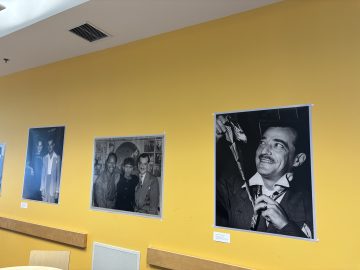
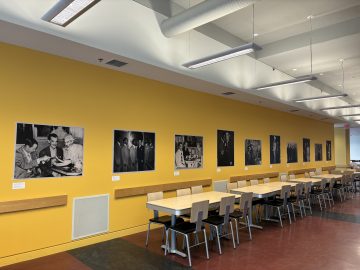


All About Oscar is curated by Krisztina Laszlo (Rare Books and Special Collections) and Barbara Towell (University Archives). We were unable to ascertain the names of some of the people in the photographs. Please contact us at rare.books@ubc.ca if you recognise anyone we could not identify.
Ancestry. n.d. “Solomon Blanck.” https://www.ancestry.ca/search/?name=Solomon_Blanck&event=_winnipeg&location=3243&priority=canada (accessed Oct. 9, 2023)
Bank of Canada. n.d. “Inflation Calculator.” https://www.bankofcanada.ca/rates/related/inflation-calculator/ (accessed Oct. 8, 2023)
Bollwitt, Rebecca. 2012 “Vancouver History, Photographer Art Jones.” Miss604. Nov. 7, 2012. https://miss604.com/2012/11/vancouver-history-photographer-art-jones.html (accessed, Oct. 8, 2023)
Cottrell, Alf. 1951. “But Listen.” The Vancouver Daily Province. March 10, 1951. https://www.proquest.com/hnptheprovince/docview/2368740460/B9BD5FA481664AEEPQ/1?accountid=14656 (accessed, Oct 8, 2023)
Donaldson, Jesse. 2019. “The Forgotten Clubs That Brought Vancouver Nights to Life.“ Montecristo Magazine, January 20, 2019, updated May 17, 2021. https://montecristomagazine.com/community/vancouvers-forgotten-nightlife-clubs (accessed Oct. 6, 2023)
Jewish Heritage Centre of Western Canada. n.d https://www.jhcwc.org/jhc-search-detail/?sid=12912&tp=articles&pg=1 (accessed Oct. 8, 2023)
Mackie, John. “Pavel Bure, Sonny Homer’s red pants, and Ralph Bower.” The Vancouver Sun. Jun 10, 2018. https://vancouversun.com/news/local-news/pavel-bure-sonny-homers-red-pants-and-ralph-bower. (accessed Oct. 8, 2023)
Posner, Sharon. 2018. Interview by Debby Frieman. The Scribe: The Journal of Jewish Museum and Archives of British Columbia, Volume 37: 20-24.
Richards, Dal and Jim Taylor. 2009. One More Time: The Dal Richards Story. Harbour Publishing 2009
Trotter, Graham. 1954 “Five Victims of Air Crash Identified.” The Nelson Daily News, April 12, 1954. https://open.library.ubc.ca/viewer/nelsondaily/1.0427552#p0z-2r0f: (accessed Oct 6, 2023)
Vancouver Daily Province. 1948. “Ties and T-bone Steaks Have Made Him Famous.” Dec 11, 1948. https://www.proquest.com/historical-newspapers/december-11-1948-page-80/docview/2368956007/se-2. (accessed Oct. 08, 2023)
Vancouver Daily Provence. 1954. “Eyewitness Accounts: TCA Crash Scene Terrible.” April 9, 1954, https://www.proquest.com/historical-newspapers/april-9-1954-page-3-44/docview/2369136451/se-2 (accessed October 6, 2023).
Vancouver Daily Province. 1954. “Victim’s Relatives Seek $1,795,000: Families, Estates Sue Crown for Airline Disaster.” Oct 14, 1954.October 14, 1954 (Page 10 of 42) – ProQuest Historical Newspapers: The Province – ProQuest (accessed Oct 6, 2023)
Wasserman, Jack. 1955. “About Now.” The Vancouver Sun. Mar 26, 1955, https://www.proquest.com/historical-newspapers/march-26-1955-page-29-64/docview/2240206669/se-2 (accessed Oct 8, 2023)
Posted in Collections, Exhibitions, Frontpage Exhibition, Research and learning | Read More | No Comments
By Jillian on April 30, 2024
A comparatively warm and dry winter here in British Columbia has experts predicting a bad year for wildfires across the province. While wildfires have always been a natural part of British Columbia’s seasonal cycle, increasing seasonal average temperatures and decreased precipitation are contributing to longer, more widespread and more destructive wildfire seasons, with four of the worst seasons in recorded history having occurred in the past 7 years (2017, 2018, 2021, and 2023).
Unfortunately, human activity is the cause of about 40% of wildfires in the province. Human caused wildfires may be either intentional or unintentional and can include causes such as open burning, industrial activity, fireworks, sky-lanterns, improper discarding of burning items such as cigarettes, or arson. While this is a frustrating statistic to digest, the silver lining is that there is great potential for wildfire prevention through proper education, awareness and subsequent behavioral changes.
This blog post contains advertisements and newspaper articles published in B.C. between 1904-1981 regarding wildfire prevention. These materials are from our BC Historical Newspapers collection which is available through UBC’s Open Collections.
It is interesting to observe the difference in how wildfire prevention was addressed in the 20th Century compared to how it is addressed in contemporary media. Historically, the major focus to inspire wildfire prevention was to emphasize the negative economic and industry impacts of the destructive blazes. Today, while the economic and financial impact of wildfires is still part of the conversation, it is more common for the focus to be on climate change, ecological impacts, health risks and loss of life. These differences are indicative of a shift in shared cultural values as well as scientific advancement that has allowed for better understanding of the causes and long term ecological and health impacts of wildfires.
While this blog post is not an educational resource on wildfire prevention, we hope that it inspires you to be wildfire aware and practice safety precautions when enjoying the great outdoors. For information on wildfire prevention, please visit the BC government’s webpage, which contains several resources.
Similkameen Star – August 1904
This article from the Similkameen Star discusses the responsibilities of individuals to reduce the risk of wildfires.
Cumberland Islander – July 1929
This advertisement from the Cumberland Islander in 1929 highlights the devastating impact of wildfires on raw materials, and the rippling economic impact that raw materials shortages have on other Canadian industries.
This public opinion advertisement from the B.C. Forest Service emphasizes the ‘hostile’ public attitude to ignorance that results in harm and encourages people not to be careless.
The Princeton Star – August 1930
Wildfires are a direct risk to Canadian forest industries; this advertisement frames the economic impact of wildfires on Canada’s national wealth and advises Canadians to “be careful with fire while in the woods”.
Similkameen Star – December 1938
This warning to hunters and fisherman was published in the Similkameen Star by the Game Commission. It warns outdoorsman of hunting accidents and wildfire risks and the precautions that should be taken to avoid harm and ensure an enjoyable and safe experience.
This wildfire prevention advertisement was featured in The Coast News in 1947. Once again this ad emphasizes the value of losses caused by wildfires. The Minister of Lands and Forests warns people to “BE CAREFUL WITH FIRE! PREVENT FOREST FIRES!”.
Sunshine Coast News – March 1981
The Province of BC’s Ministry of Forests ran this advertisement in the Sunshine Coast News in 1981. The advertisement is regarding the Ministry’s new policies on “costs and action responsibilities for wildfires in British Columbia”.
We hope you enjoyed seeing these vintage wildfire prevention ads, and that you were inspired to practice preventative measures while enjoying the outdoors.
Thank you for reading!
Posted in BC historical newspapers, BC wildfire, British Columbia History, Carousel, Digitizers' Blog, open collections, wildfire prevention, wildfires | Read More | No Comments
By Library Communications on April 22, 2024
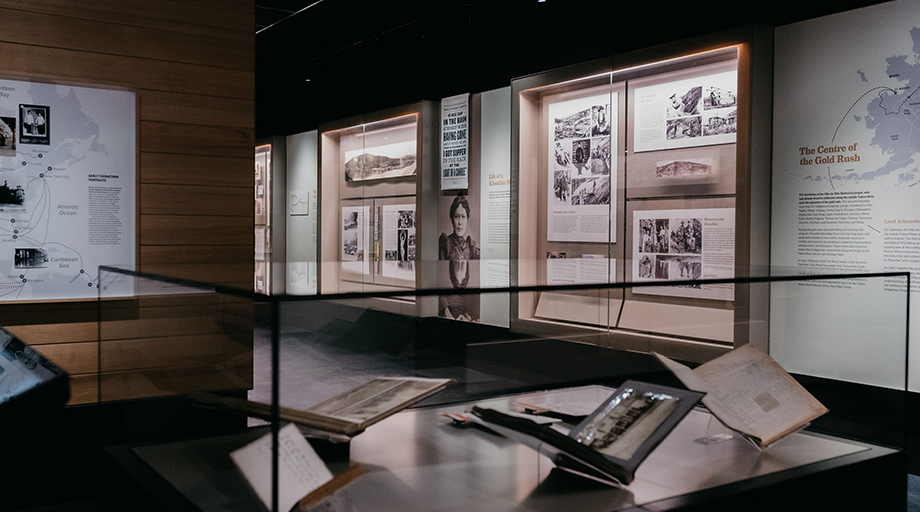
UBC Library is excited to announce the official opening of the Chung | Lind Gallery showcasing the Wallace B. Chung and Madeline H. Chung Collection and Phil Lind Klondike Gold Rush Collection. The new exhibition space in the Irving K. Barber Learning Centre on UBC’s Vancouver campus brings together two library collections of rare and culturally significant materials from Canada’s history.
The complementary collections explore the economic and social growth of early B.C. and the Yukon through exhibits that reveal stories about the Indigenous experience and the experience of Chinese immigrants to B.C. The gallery will provide faculty, students and the public with direct access to two significant Canadian cultural properties.
“We’re thankful to everyone who made the Chung | Lind Gallery a reality, after many years of planning and effort to create this remarkable space. Displayed together, these two outstanding collections will create a new focal point for historical research, teaching and learning at UBC, and in time become a magnet for scholars across Canada who wish to view these rare materials first-hand,” said university librarian Dr. Susan E. Parker.
“We are thrilled to have the opportunity to bring together these two avid and dedicated collectors—Dr. Chung and Mr. Lind—who share such a passion for history and material culture. And by putting their collections in dialogue with each other, we’ve discovered unexpected resonances. Now being displayed together publicly in the new Chung | Lind Gallery, we know the collections will continue to enrich and inform each other, providing new and exciting possibilities for learning and scholarship,” said Katherine Kalsbeek, head of rare books and special collections.
The Chung | Lind Gallery includes approximately 292 square metres of display space on the second floor of the Irving K. Barber Learning Centre. The space has been renovated to meet Canadian Conservation Institute and department of Canadian heritage guidelines and requirements for displaying, protecting and preserving heritage collections. Public and Page Two provided design support for the space.
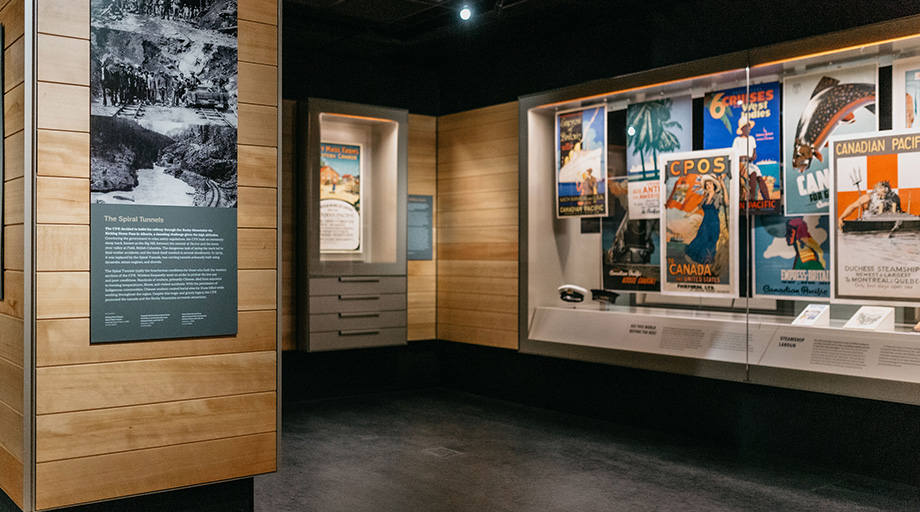
The Chung | Lind Gallery. Credit: UBC Library Communications and Marketing
An achievement in visual storytelling, the Chung | Lind Gallery features both rare treasures from the collections and modern marvels. At the entrance, a large-scale model of Canadian Pacific Railway (CPR) company steamship, the Empress of Japan, restored by Dr. Chung, rides the waves over a virtual ocean designed by Dutch Igloo. Further into the gallery, a miniature log cabin comes to life with projected scenes from the Klondike era.
Funding for the gallery renovation was generously provided by Phil Lind, the UBC President’s Priority Fund, the London Drugs Foundation, donors to the library, and by the Canadian government through the department of Canadian heritage’s Canada Cultural Spaces Fund.
“Libraries play a pivotal role in preserving and sharing Canada’s history and heritage, providing invaluable access to historically significant materials. They are custodians of collective wisdom, where every book can transport us to a moment in time and every shelf offers boundless opportunities for discovery. Thanks to the newly opened Chung | Lind Gallery, now and in the future, you can learn more about important moments in our country’s history and take in rare collections being showcased. Congratulations to the University of British Columbia and everyone involved in turning this dream into reality!” said Pascale St‑Onge, minister of Canadian heritage.
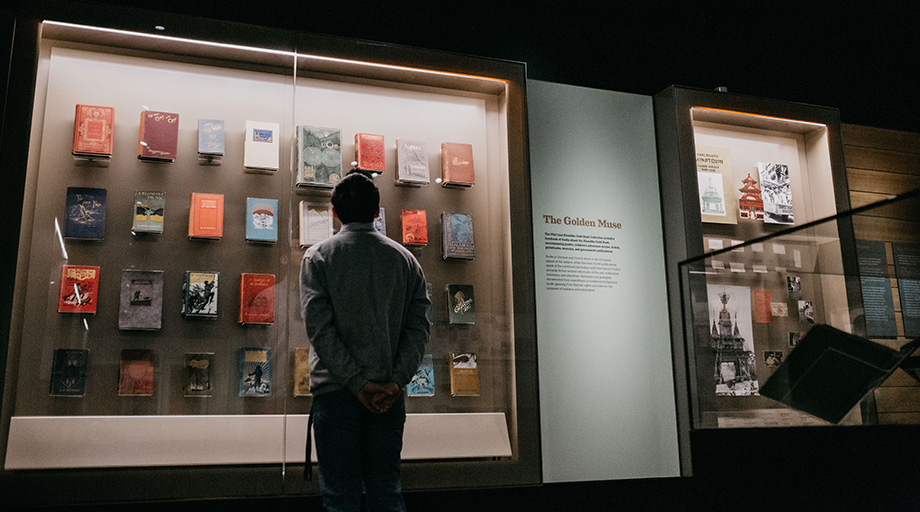
The Chung | Lind Gallery. Credit: UBC Library Communications and Marketing
The Wallace B. Chung and Madeline H. Chung Collection, donated to UBC Library in 1999, contains more than 25,000 rare and unique documents, books, maps, posters, paintings, photographs, tableware and other artifacts that represent early B.C. history, immigration and settlement, particularly of Chinese people in North America and the CPR. Items from the Chung Collection were previously on display at RBSC. The new gallery space will bring this collection further into the public eye and provide new opportunities for community engagement.
The Chung Collection has been designated as a national treasure by the department of Canadian heritage’s Canadian Cultural Property Export Review Board (CCPERB), and has been named to the Canadian Commission for UNESCO’s Canada Memory of the World Register.
“This collection started with an interest in my neighbourhood. My family was confined to Chinatown, and I became curious about the history of the people that lived there. Many people do not know how difficult things once were for early Chinese migrants. While the world has changed, this was only possible through first understanding the past. Our future is tied to history; to move forward, we must forgive the ills of the past, but we should never forget,” said Dr. Wallace Chung.
The Phil Lind Klondike Gold Rush Collection is an unparalleled rare book and archival collection dating from the Klondike Gold Rush, donated to UBC Library in 2021 by UBC alumnus and Canadian telecommunications icon Philip B. Lind, CM. The gift included $2 million to support the collection and the gallery renovation.

The Chung | Lind Gallery. Credit: UBC Library Communications and Marketing
The Lind Collection includes books, maps, letters and photos collected by Lind in honour of his grandfather Johnny Lind, a trailblazer and prospector who operated and co-owned several claims on Klondike rivers and creeks. The Lind Collection has been designated as a cultural property of outstanding significance by the CCPERB.
“The Lind family is honoured to have the Phil Lind Klondike Collection housed at UBC Library. Our father’s collection stemmed from a fascination for his grandfather, John Grieve Lind, and grew into a passion that followed him through his life. He wanted to share this underrepresented history with the academic community and for future generations to enjoy. It is truly unique to share this space with The Chung Collection, bringing together two disparate histories of west coast Canada from the turn of the century that are integral to the formation of the notion of the west,” said Jed Lind.
The Chung | Lind Gallery was unveiled with a special ribbon cutting ceremony on Friday, April 19, attended by members of both the Chung and Lind families and UBC president and vice-chancellor Dr. Benoit-Antoine Bacon. The gallery will open to the public on May 1.
Explore photos of the Chung | Lind Gallery.
Media contacts
Erik Rolfsen
Media Relations Specialist
Tel: 604.822.2644
erik.rolfsen@ubc.ca
Anna Moorhouse
Manager, Communications & Marketing, UBC Library
Tel: 604.822.1548
anna.moorhouse@ubc.ca
Posted in Carousel, chung collection, Chung Lind Gallery, General, Phil Lind Klondike Gold Rush Collection | Read More | No Comments
By Library Communications on April 18, 2024

UBC authors looking to publish in peer-reviewed journals by Oxford University Press and Elsevier are now eligible for cost-savings thanks to new transformative agreements signed by the Canadian Research Knowledge Network (CRKN).
In February 2024, CRKN signed a new three-year, read-and-publish agreement with Oxford University Press (OUP). With this agreement, scholarly authors at UBC and other member institutions will be eligible for unlimited open access publishing in more than 350 OUP hybrid journals at no cost to the author. Authors can also benefit from a 10% discount on article processing charges (APCs) when publishing in OUP’s gold open access journals.
More recently, in April 2024, CRKN followed up by announcing a new three-year, read-and-publish agreement with Elsevier. Authors at participating member institutions, including UBC, will benefit from unlimited open access publishing in Elsevier’s hybrid journals without having to pay an APC. This includes more than 1,800 hybrid journals and 165 core hybrid specialty titles in Elsevier’s catalog.
“The new transformative agreements have already had a positive reception from faculty at UBC. There has been a growing interest from campus researchers to publish open access, but the issue of faculty assuming the publication costs has created a challenge that is difficult to overcome. With these new kinds of agreements the costs to publish and read are bundled together, removing that challenge,” says Erin Fields, Open Education and Scholarly Communications Librarian at UBC Library Digital Initiatives. “With the agreements with Elsevier and Oxford University Press, two of the larger publishers of UBC research, we hope faculty will take advantage of publishing open access, which is proven to increase access and readership.”
Transformative agreements have been changing open access publishing at UBC and are a clear indicator of UBC Library and UBC Okanagan Library’s continued commitment to open access. UBC’s participation in these transformative agreements, and as a CRKN member institution, is a joint effort co-funded by UBC Library and UBC Okanagan (UBCO) Library. Together, UBC Library and UBCO Library are able to significantly reduce or even eliminate the costs of open access publishing that would normally be paid by UBC authors, and instead enable those authors to redirect much needed funds back towards their research efforts.
Find out more about all the open access publisher discounts available to authors at UBC.
Posted in Carousel, General, Open Access, research learning and scholarship, Scholarly communications | Read More | No Comments
By Jillian on April 16, 2024
This week’s blog post is a selection of dinner menus from the Chung Collection, which is held at UBC Library’s Rare Books and Special Collections. The Chung Collection contains many materials including travel pamphlets, itineraries and menus from the Canadian Pacific Railway Company, which was a large enterprise that dealt in railway and non-railway transportation and travel. These menus are from the commercial passenger trains, steamships and hotels and offer insight into the lavish fare that one could expect from these extravagant excursions.
Empress of Japan, 16th April 1931
Today in 1931, this beautiful art deco illustration was the cover of the “au revoir dinner menu” on the Empress of Japan. The menu features wine suggestions, dinner, salad and dessert offerings.
This dining car menu is from the Dominion train in 1936 and includes both set and a la carte menus. It features a beautiful photograph of Kicking Horse River on the cover.
Empress of Britain, Meridian Day menu, 1937
This Meridian Day menu from the Empress of Britain features musical selections alongside the dinner menu. The cover of this menu features an illustration of the ship and a golden chariot being pulled by three white horses.
Empress of France, 17th September 1955
This menu is from the Empress of France and features a beautiful view of Castle Mountain from the Canadian Pacific Railway Line on the front page. The menu also features information about the mountain on the back page, including the reason for its renaming in 1946 from Castle Mountain to Mt. Eisenhower, the name which it held until 1979.
I hope you enjoyed seeing what passengers on Canadian Pacific trains and steamships were eating in the 1930’s-50’s.
Thank you for reading!
Posted in Carousel, CPR, Digitizers' Blog, dinner menu, menus, open collections | Read More | No Comments